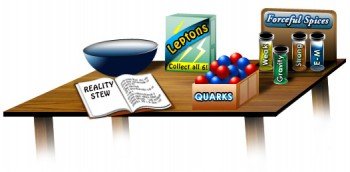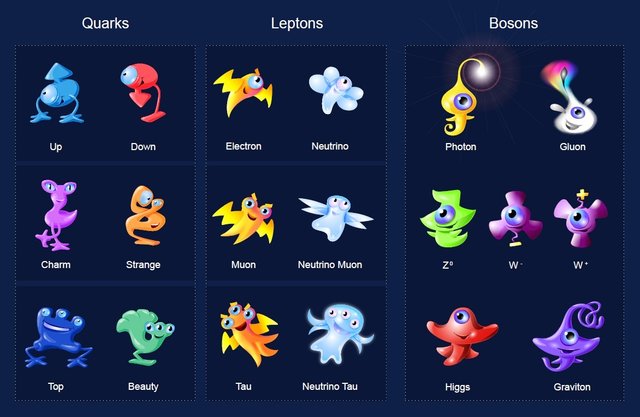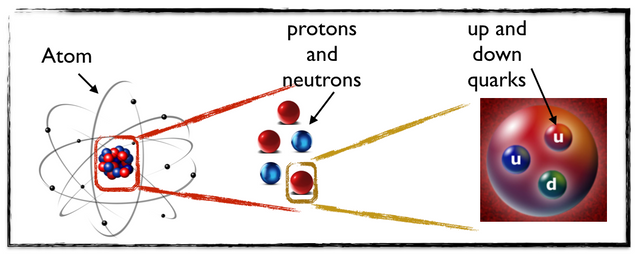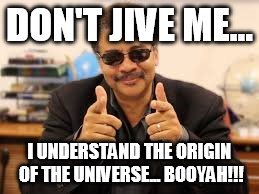Particles and quantum fields for laymen (and thus Steemians)
More and more, people are telling me that particle physics is today introduced at the high school level. For instance, this is the case in some high schools in France. I have also learned recently that this was the case in Norway too (@fredrikaa may know better about it).
I am sure that this is also true for other countries (please let me know in the comments to this post).

[image credits: The Particle Adventure]
Particle physics relies on tough concepts, like quantum mechanics, special relativity, field theories and gauge theories, that are on top of being complicated, all mixed together.
It is thus not too easy to share the information with people that have not any high-level mathematics background, without paying the price of oversimplifying and introducing errors. Simplifications are fine but one must keep the description correct.
The theory describing how the elementary particles work is called the Standard Model of particle physics. The four (theoretical) ingredients underlying its construction have been named above, and can be gathered into two notions:
- quantum field theory that is the merging of field theory, quantum mechanics and relativity;
- gauge theories that explain how to relate symmetries to interactions, or forces, and use that for their modeling.
In this post, I will discuss quantum fields, what they are, and how to connect them to particles. In a second post that I may write later (somehow… I am not very good in keeping the schedule :p), I will focus on the second concept of gauge symmetries.
QUANTUM FIELD THEORY
Particle physics theories rely on quantum field theories. This means that the basic quantity which everything will be built upon, is a quantum field. One good way to explain what a quantum field is is to connect it to the notion of particles.
But we must be careful, a quantum field is not a particle. What do you think a particle is? Please answer the question for yourself before reading the rest (and do not hesitate to share your answer as a comment).

[image credits: CERN]
Just for the fun, a representation of the Standard Model particles can be found in the image above. I have these as magnets at home on my fridge. Is anyone reminding the plush representation of the particles? Here is now the magnet one!
Let us now be serious again…
A quantum field is not a particle. It is a complex object that is the fundamental building block to construct any theoretical description of the microscopic world.
Particles are instead oscillations of the fields, as antiparticles by the way. A given field is related to both particles and antiparticles. This is why, at the end of the day, a particle and an antiparticle of a given species are very similar.
Moreover, those oscillations of the fields are quantized, as we are living in a quantum world at the microscopic level. As one can imagine, particles are hence far from solid balls colliding with each others :) We must thus bear in mind that a 'particle' is an effect of quantum mechanics with therefore non-common properties.
But apart from these technicalities, it is easy to relate the particles to the fields and call both with the same name.
MORE ON PARTICLES
So here, I deliberately match particles and antiparticles as those are just two types of excitations of a given field. I will not enter the mathematical details, as this is not the goal of the post, but I will focus on the particle (or field) content of the Standard Model.
The Standard Model of particles physics describes the behavior of 12 elementary particles, who are introduced in the above picture. We have hence 6 quarks and 6 leptons organized in three families:
- three up-type quarks: the up (u), the charm (c) and the top (t);
- three down-type quarks: the down (d), the strange (s) and the bottom (b);
- three charged leptons: the electron (e), the muon (mu) and the tau (tau);
- three neutrinos: the electronic, muonic and tau neutrinos (nu).
All matter around us can be built from up and down quarks, and electrons, as illustrated in the picture below where I decompose an atom into its most elementary constituents.

[image credits: homemade (from stuff available everywhere)]
Neutrinos are also there, and they have then been discovered in radioactivity studies (I wrote about that recently, please check this article).
The reason why everything is multiplied by 3 is unknown, and physicists are trying to get hints about that. What we need to remember is that each elementary particle has heavier brothers and sisters, and that we have 12 guys in total.
INTERACTIONS
I will not deeply discuss interactions today, as this is the topic of the second post of gauge symmetries that I have promised to write later.
I will mention instead that in the Standard Model, three out of four fundamental forces are described: electromagnetism, the weak interaction and the strong interaction. Gravity is indeed too weak to be relevant, as the gravitational strength is proportional to the mass of the objects involved (and particle masses are tiny).
Gauge symmetries (the concept I will not describe today) allow to model each interaction by the exchange of a mediator. One say that two particles interact electromagnetically when they exchange a photon. W-bosons and Z-bosons are related to the weak interactions, and gluons to the strong interactions.
How the interactions arise is a good question, and is entirely dictated by enforcing the theory to respect a symmetry called a gauge symmetry. More details will follow later this week.
And as you all know, we also need a Higgs boson to make everybody massive. The particles are indeed observed massive in the experimental data. I have written a couple of posts on that in the past (see here and here), and I may come back to it in the future too, if some of you want to.
SUMMARY AND REFERENCES
In this post, I have discussed a little bit the notion of particles and the one of quantum field. I have underlined the links between them and I have then described the particle content of the Standard Model.
What is still missing is the way the fields interact. I mentioned the words of ‘gauge theories’. How actually how everything stems from symmetries.
The idea behind the writing of this series of two or three posts comes from this paper that I have recently read, where particle physics teaching is discussed. The last part of the post is made of well-known stuff that can be found everywhere (just wikipedia it for instance).
And please do not hesitate to tell me what you really thought a particle was before reading this post :)
For more discussion on this topic (or anything related to science), please join us on #steemSTEM.
SteemSTEM is a community driven project which seeks to promote well written/informative Science Technology Engineering and Mathematics postings on Steemit. The project not only curates STEM posts on the platform, but also re-distributes rewards as STEEM Power to members of Steemit's growing scientific/tech community. More information on our actions is available here. You can also follow our curation trail to support us (contact us on the chat for practical details). We thank you for your generous support.
This is quite a complex topic to add to high school. I hope they don't over simplify the concepts and introduce wrong ideas!
Even what you wrote is a little bit complex and I had to read it twice to grasp the basic concepts.
Thanks for sharing
To summarize, forget the "colliding sphere" concept for a particle. This is a complicated object (connected to a quantum field). From there, one can start building the Standard Model of particle physics, the theory that describes the world of the elementary particles. We have 12 fields (or abusively, particles) in the matter sector, which are those given in the magnet figure above.
Is that clearer? :)
I admit that these concepts are way easier to explain live than in a written way :)
Yes it is clearer now thanks :)
Do you think that there will be more particles added to the Standard Model or are scientist sure that this is final?
We are pretty convinced it is not final. You can for instance check this old post I wrote 8 months ago where I explain the motivations for going beyond the Standard Model. However, nature is tricky we we don't have any hint for anything new so far.
This could be a very long answer! In essence, some particle physics is introduced even in the IGCSE exam (14-16 yo) but the discussion of the fundamental concepts is left out!
The first introduction concerns an explanation of beta decay in terms of a neutron miraculously changing into a proton, electron and anti-neutrino. The syllabus goes as deep as the down quark changing to an up quark. The why of it all is left for the future.
Indeed, the bizarre introduction of the anti-neutrino is left unexplained, even though the concept of spin is later crucial when learning how an MRI machine works - but even then, particle spin is not officially in the syllabus.
I will very soon write on a recent experience at A level (16-18 yo) physics, teaching the production of X-rays by electron transitions. I do not expect a university level explanation as students lack the mathematical tools, but, again, the fundamental ideas are missing. Students need to express complex ideas parrot-fashion without much understanding.
I wish schools would teach engineering and thereby clean up the physics syllabus, and bring mathematics back into it.
There are ways to share things. Always. It is not easy, but as you said, the essence of it can be transferred. In the next part of this post (hopefully next week), I will show how the different time zones on Earth can be used to understand the gauge symmetries. No need to any deep QFT knowledge here to get the roots of it :)
Good stuff! Thanks for compiling the info.
What still intrigues me is the no. 3. There's definitely something there that needs to be found or connected. I've played around with the number of electrons of an element, it's stability and it's decay patterns to see if there is any correlation.
Moreover, there is still much to be found out in the aether :-)
The number of families os a great mystery in particle physics. There are models tempting to explain it.
For the nucleus chart you showed me, you have the magic numbers that help to understand the pattern. I wrote on this a year ago here. I hope this to be helpful.
The aether-um you mean? ;)
Wow unbelievably good post but I am sorry to say.... I hope they never ask me to teach this to my kids , I will totally throw my name away hahaha. Hats off to you for an awesome explanation. Resteeming for all the "clued up" steemians
The average age of the kids is roughly the end of their high-school time (16 or 17 years old). For this, the teachers are particle physicists. They are the best for answering questions :)
I can come and teach your kids ^^
Thanks - for science I only have the little ones so I think they will be a bit confused hahaha
But how wonderful that kids are just learning more and more
I have bought magnets with the colored and fancy-shaped particles above. I can hence play particle physics collisions with my little ones. But usually, I stop there. This is way too hard for small kids. One indeed needs the big ones here :)
interesting article, I do not know much about physics but if I have some knowledge regarding quantum, well I actually had a boyfriend who studied physics, but he was more dedicated to the area of the physics of semiconductor materials
Condensed matter physics is indeed way more trending than particle physics those days. This is a pity (at least for me :p) but this is how it is. And regarding in terms of the number of tenured jobs we can offer, I think it is better that way too.
Is quantum mechanics taught in medical schools in Venezuela?
The University of Zulia there are very good professionals in physics, in maracaibo recently opened a masters of physics-medicine, I have colleagues who are studying that career and are teaching them part of the physical and physical physics of the solid state, I do not have much knowledge to respect but my friends talk a lot about it, there really is a lot of potential in my country, but employment is very scarce. Most of the best professionals in physics have left the country due to the current situation and because their knowledge is very good, they really teach here physically is excellent, as well as venzuela is recognized for having the best doctors in different branches of medicine, we are looking for a lot of other countries to work, I in the future I plan to do it, soon I will start my postgraduate course in surgery and after culminating I could think of emigrating to another country.
I see. All your brains go away and there is very little means, at least today, to attract them back. Many countries suffer from the same problem. I think however that in the Venezuela case, the political situation makes it worse.
I hope you will manage to accomplish your dream :)
We still hope that the country will change, but the reality is another government does not want to let go of power and many people are decpecionan and see the only way is to leave the country and start from scratch
It is something very tough. I am very sad to read that, but this sound to be the only reasonable solution.
I hope everything changes for the good of all Venezuelans, thank you very much for your good comments and be interested in the situation of my country, you are an excellent person @lemouth
It was an excellent discussion too. Thanks for the opportunity :)
I would be moderately impressed if people started learning about gauge fields, fibre bundles, path-integrals and Green's functions in High school nowadays :D
Maybe in 50 years but definitely not now, I would say. But there are things that can be taught. My oldest kid nows what is (very roughly) a Higgs boson ^^
Well. I've read some here and there over the years and this is a good general discussion!
The book that really tuned me into this field of physics was Gary Zukav's The Dancing Wu Li Masters. I ran into it in the early 1980s.
He used metaphors from the Huayen school of Buddhism, Fazang's treatise on The Golden Lion. Being interested in all things "eastern" I liked the way it helped me follow the intricacies of the particles seeing this branch of physics like a dance.
I am not too sure about what to answer, as I have not read that book (and I have not the time to do it at the moment, unfortunately).
I am not so sure we can relate how particles behave to dancing, but if you connect the dance to the mathematics that lie behind, why not (as I said, I haven't read the book) :)
I love this stuff, but i have a hard time getting it to stick, i was grinding hard on some neil degrasse tyson and leonard susskind on youtube about 2 years backs. in another life i'll be a physicist, when i can actually understand physics. (-:

The key is the time. Understanding physics takes long. I hope I gave give hints to this path with my posts :)
I am doing maths with young children, perhaps the little ones should start sooner with the basics to understand better when they get older, I dont know but just wondering. Thank you for an awesome post
It really depends what you define as little. I gave an introduction talk to particle physics to 12 years old kids a couple of years ago, explaining what I was doing, etc. It worked pretty well and half of the class interrupted me all the time with very good questions.
Should I say they're lucky? I never saw much about particle physics until my College years. The thing is, how will a complex field like this fit into high school syllabus?
This must be taught in the format of an informal seminar. This works way better. This is how I usually do and the results are just great :)